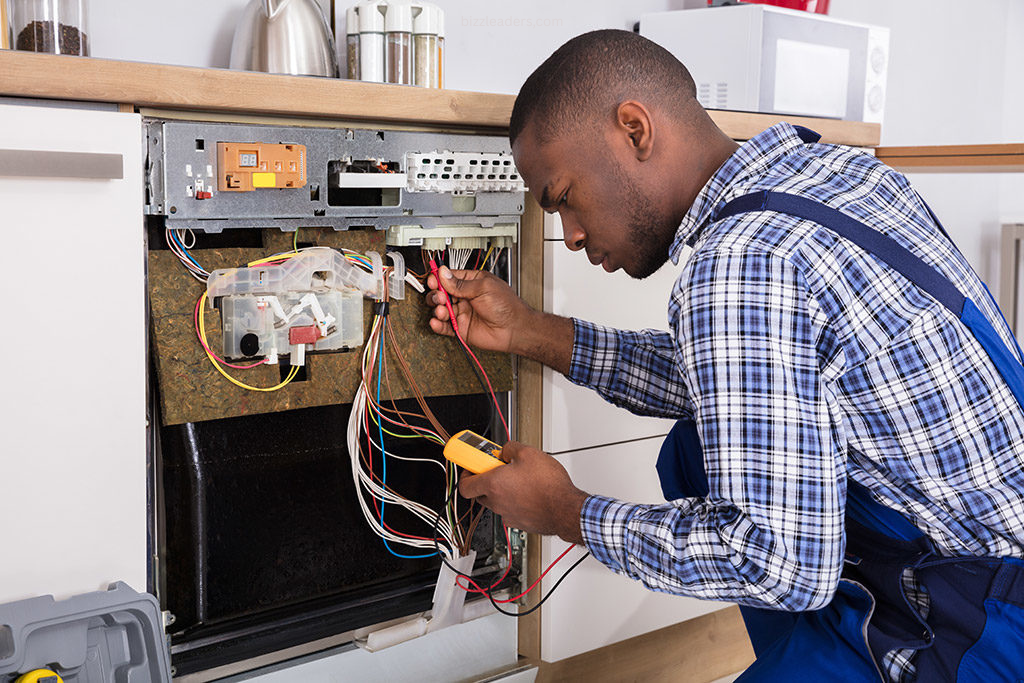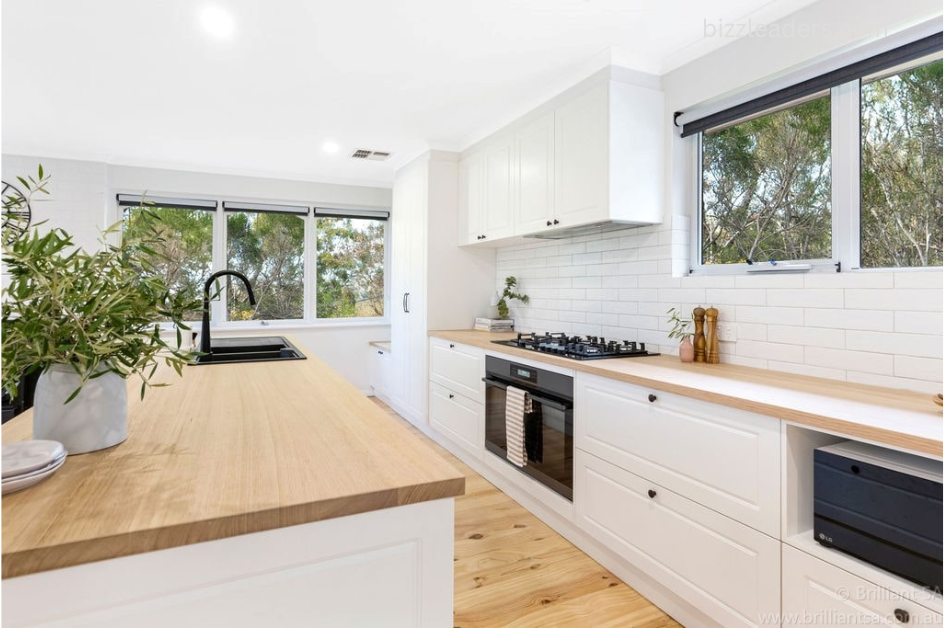When it comes to planning your dream kitchen, it’s tempting to obsess over cabinets, splash backs, and fancy appliances. But if there’s one thing that quietly does the heavy lifting — it’s your benchtop.
Think about it: it’s where you prep, cook, serve, spill, and sometimes even eat. It’s the most-used surface in the room, and it can completely change the feel of your space.
Choose the right material, and you’ve got a kitchen that’s both stunning and hard-wearing. Go for the wrong one, and you might end up with stains, scratches, or something that just doesn’t age well.
Whether you love the sleek look of engineered stone, the warmth of timber, or the drama of marble, your benchtop sets the tone — both in style and in how your kitchen works day-to-day.
porcelain benchtops: stylish, durable, and low-maintenance
Porcelain benchtops are quickly becoming a favourite in modern kitchens — and for good reason. They offer a sleek, sophisticated look with a wide range of finishes that can mimic marble, concrete, or even metal. But it’s not just about style — porcelain is incredibly durable, resisting scratches, heat, UV, and stains with ease.
Best of all, it’s low-maintenance, making it perfect for busy households or anyone who wants a beautiful kitchen without the upkeep. If you’re after a benchtop that combines designer appeal with everyday practicality, porcelain is hard to beat.
resistance to stains, scratches, and heat
Porcelain benchtops aren’t just about good looks — they’re built to last. Thanks to their high-density surface, they’re incredibly resistant to stains, scratches, and heat, making them a smart choice for hardworking kitchens.
You can place hot pots directly on the surface, chop without a cutting board, and wipe away spills without worry. It’s a stylish, low-maintenance option that handles real-life messes without compromising on design.
versatile kitchen for modern and classic kitchen
Porcelain benchtops are incredibly adaptable, making them a fantastic choice for various kitchen design styles. Whether your vision leans towards a sleek, current design trend or a more enduring, classic feel, porcelain seamlessly integrates into the space.
With an extensive range of finishes available — ranging from soft, stone-like textures to striking marble designs — you’re sure to discover an option that aligns with your preferences. This super versatile material enhances both minimalist environments and cozy, traditional kitchens equally well.
plumbing matters: avoid surprises after installation
When it comes to plumbing, the last thing any homeowner wants is a surprise—especially after the installation is complete and the walls are sealed. Unexpected leaks, poor drainage, or inaccessible shut-off valves can quickly turn a finished project into an expensive headache.
That’s why careful planning, hiring qualified professionals, and thorough inspections are key. Before any pipes are hidden behind walls or floors, it’s essential to test for leaks, confirm proper venting and drainage, and ensure fixtures are installed correctly.
A detailed walkthrough after installation can catch issues early—like reversed hot and cold water lines or weak water pressure—saving time, money, and frustration down the road. In plumbing, peace of mind comes from doing it right the first time.
the importance of checking plumbing before installation
Taking the time to review the layout, measure pipe runs, verify water pressure, and inspect existing lines for damage or corrosion can prevent major issues down the line. Pre-installation checks help ensure that the new system will function properly, comply with local building codes, and integrate smoothly with existing infrastructure.
Skipping this step can lead to costly rework, delays, or even water damage after everything is installed. A thorough plumbing check before installation isn’t just good practice—it’s essential for protecting your investment and ensuring the long-term success of your project.
prevent future plumbing issues with pipe relining
Pipe relining is a modern, non-invasive solution that helps prevent future plumbing issues without the mess and expense of digging up your yard or tearing through walls. Instead of replacing damaged pipes entirely, relining reinforces them from the inside using a durable epoxy resin liner. This creates a seamless, corrosion-resistant pipe within the existing one—perfect for fixing cracks, leaks, and root intrusion.
Not only does this method extend the life of your plumbing system, but it also minimizes disruption and reduces the risk of future blockages or costly repairs. If you’re dealing with aging or damaged pipes, pipe relining is a smart, long-term investment in the health and efficiency of your plumbing.
power outlets and appliances need reliable wiring
Designing your dream kitchen involves more than just choosing stylish finishes—functionality is key, especially when it comes to your benchtop and electrical setup. Your benchtop isn’t just a workspace; it’s home to essential appliances like kettles, toasters, and blenders. That’s why it’s important to ensure that power outlets are positioned conveniently and that all appliances are supported by reliable wiring. Safe, well-planned electrical work behind the scenes is just as critical as the materials you see. Faulty wiring can lead to appliance damage, power issues, or worse—so while you’re selecting the perfect stone or timber finish, don’t forget to prioritize quality wiring and electrical layout. It’s the foundation of a kitchen that not only looks good but works seamlessly every day.
ensuring safe and compliant electrical systems
Ensuring a safe and compliant electrical system is essential for the long-term performance and safety of your kitchen. With multiple high-powered appliances, task lighting, and conveniently placed outlets often concentrated in one space, your kitchen’s wiring must be up to code and capable of handling the load.
A licensed electrician should be involved early in the design process to plan circuit layouts, outlet placement, and proper grounding. Not only does this prevent hazards like overloaded circuits or electrical fires, but it also ensures you pass inspections and meet current building regulations. A well-designed electrical system isn’t just a requirement—it’s the backbone of a functional, future-proof kitchen.

why you should hire an emergency electrician
When you’re working in the kitchen, a sudden electrical problem can cause a lot of stress and even be dangerous. If an outlet starts sparking, the power goes out, or something smells like it’s burning, it’s important to call an emergency electrician right away.
They can come quickly and fix the problem safely, so you don’t have to worry about fires or damage to your appliances. Kitchens use a lot of electricity with all the appliances and outlets, so having an expert ready to help in an emergency keeps your kitchen safe and working properly.
conclusion
A dream kitchen isn’t just about beautiful materials — it’s about lasting functionality. From benchtop surfaces to the hidden work of plumbing and wiring, every decision plays a role in how your kitchen performs every day.
Investing in durable materials, professional installation, and thoughtful planning means your kitchen won’t just look incredible — it will stand the test of time.
FAQs
Why is the choice of benchtop material crucial in kitchen design?
The benchtop is not just a surface; it’s the centerpiece of your kitchen. It influences aesthetics, functionality, and durability. Choosing the right material ensures your kitchen reflects your style while standing up to daily use.
What are the most popular benchtop materials available?
Popular options include granite, quartz, marble, laminate, and solid surface materials. Each has unique qualities, so consider factors like maintenance, appearance, and cost when making your selection.
How does the benchtop affect kitchen functionality?
A well-chosen benchtop enhances workflow, provides ample workspace, and supports various kitchen activities from meal prep to entertaining. The right material can also resist stains and scratches, making your kitchen more practical.
Can I mix and match different benchtop materials?
Absolutely! Mixing materials can create visual interest and better suit different areas of your kitchen. For example, a durable surface for food prep and a more elegant finish for an island can balance aesthetics and function.
What should I consider regarding maintenance when choosing a benchtop?
Consider how much time you want to dedicate to upkeep. Materials like quartz are low-maintenance, while natural stones like marble may require regular sealing and care. Choose what aligns with your lifestyle.
How does the color and finish of the benchtop impact the overall kitchen design?
Color and finish set the tone for your kitchen. Lighter colors can make a space feel larger, while darker shades add drama. The finish — matte, glossy, or textured — can also influence the ambiance and practicality of the space.
Is there a cost difference between various benchtop materials?
Yes, costs vary significantly. Laminate is often budget-friendly, while natural stones like granite or marble can be more expensive due to sourcing and installation complexities. Determine your budget early to guide your choices.
How do I ensure my benchtop choice complements my existing kitchen decor?
Consider your kitchen’s style — modern, traditional, or rustic — and choose a benchtop that harmonizes with cabinetry, flooring, and appliances. Samples can help visualize how different materials work together before making a final decision.

